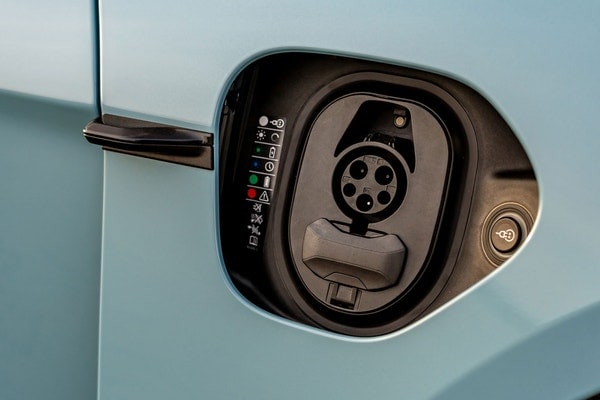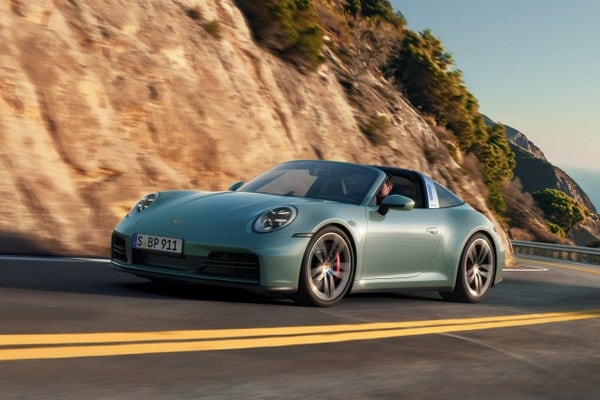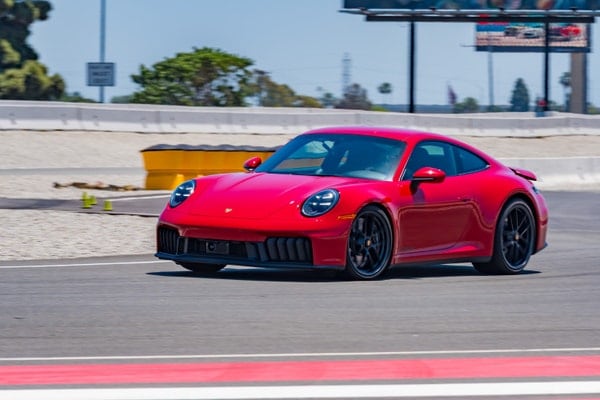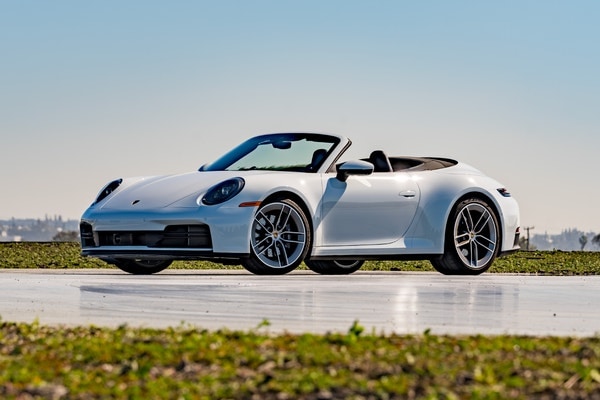2018 Porsche 911 Review
Price Estimate: $44,388 - $55,132
 View 346 more photos
View 346 more photos View 346 more photos
View 346 more photos View 346 more photos
View 346 more photos View 346 more photos
View 346 more photos View 346 more photos
View 346 more photos+342
Porsche 911 model years
Edmunds' Expert Review
Pros
- Outstanding combination of performance and civility
- Benchmark transmissions
- Rewarding driving dynamics
- Endless customization potential
Cons
- Evolutionary styling doesn't stand out like it once did
- Road noise can be excessive
What’s new
For 2018, the GT3 variant receives a significant refresh with a revised, more powerful engine, plus a unique and optional six-speed manual gearbox, revised suspension tuning and some aerodynamic tweaks. Other 911 models receive only minor changes this year. All 911 models now come with the first year's scheduled maintenance as standard. There's an improved cabin air filter and an updated color palette inside and out.
Vehicle overview
Few cars match the 911's poise in so many areas. The 911 range is at once fast yet tremendously composed, rewarding and civilized. Likewise, there are few cars that are offered in such an onslaught of variants — for 2018, there are 20 distinct 911s. Porsche's strategy of methodically rolling out a new variant nearly every six months (or so it seems) has been so successful that it has been adopted in varying degrees by many other automakers.
For sale near Ashburn, VA
165 listings
- 30,851 miles
- No accidents, 5 owners, personal use only
- 6cyl automated manual
- Porsche Arlington (27 mi away)
- Back-up camera
- Bluetooth
- Navigation
- Leather Seats
- Keyless Entry/Start
Close
Located in Arlington, VA
*PORSCHE CERTIFIED PRE-OWNED - 2 YEARS / UNLIMITED MILEAGE WARRANTY INCLUDED - 24/HR ROADSIDE ASSISTANCE* MSRP: $159,980 * Total Options: $26,980* E...
AutoCheck Vehicle History Summary
Accident Free Vehicle: Yes
Personal Use Only: Yes
History Provider: AutoCheck
Title Details: Clean Title
Salvage Vehicle: No
Frame Damage: No
Theft History: No
Lemon Status: No
Free History Report: No
Features and Specs:
21 Combined MPG (18 City/26 Highway)
Listing Information:
VIN: WP0CB2A98JS147866
Stock: 147866PC
Certified Pre-Owned: No
Listed since: 07-03-2025- $177,900fair price$141 above market
- 24,986 miles
- No accidents, 2 owners, personal use
- 6cyl automated manual
- PurMotive (55 mi away)
- Back-up camera
- Bluetooth
- Navigation
- Upgraded Headlights
- Power Driver Seat
Close
Located in Cockeysville, MD
AutoCheck Vehicle History Summary
Accident Free Vehicle: Yes
Personal Use Only: Yes
History Provider: AutoCheck
Title Details: Clean Title
Salvage Vehicle: No
Frame Damage: No
Theft History: No
Lemon Status: No
Free History Report: No
Features and Specs:
17 Combined MPG (15 City/20 Highway)
Listing Information:
VIN: WP0AC2A99JS174563
Stock: 25-0616T
Certified Pre-Owned: No
Listed since: 06-06-2025
The 911 shares its front-end architecture with the lesser 718 Boxster/Cayman models, which reduces cost — the bones from the firewall forward are largely shared. Aft of the firewall, the 911 is like no other car. Its 2+2 seating arrangement and engine hung outside of the rear axle are unique in the motoring world.
While in the past the 911's rear engine layout has been at the root of some wayward handling characteristics, there is no denying the braking and acceleration benefits that it imparts. And the modern 911 has thoroughly exorcised its more notorious habits. In the process the 911 has morphed into more of a GT car, something that is larger and more comfortable for long journeys than 911s of yore. Yet there is no denying it is an accomplished driver's car with few equals.
Edmunds' Expert Rating
8.4 / 10The Porsche 911 is the product of relentless evolution. Its rear engine placement is unique in the motoring world, and dictates its instantly recognizable styling and its fundamental driving dynamics. The Porsche 911 remains a benchmark among sports cars.
Trim tested
Each vehicle typically comes in multiple versions that are fundamentally similar. The ratings in this review are based on our Full Test of the 2017 Porsche 911 Carrera S (turbo 3.0L flat-6 | 7-speed dual-clutch automatic | RWD).
NOTE: Since this test was conducted, the current 911 has received only minor revisions. Our findings remain broadly applicable to this year's 911.
 Scorecard
Scorecard
| Overall | 8.4 / 10 |
| Driving | 9.0 |
| Comfort | 8.5 |
| Interior | 8.5 |
| Utility | 8.0 |
| Technology | 7.5 |
Driving
9.0The competence of the Carrera S spans a vast range. It expertly balances power and high-speed performance with in-town drivability and everyday use. The dual-clutch automatic gearbox is a benchmark, and its acceleration from any speed is seamless. You have to look for turbo lag to find it.
Acceleration
9.0In Edmunds track testing, the Carrera S was blisteringly fast, going from zero to 60 in just 3.4 seconds, reaching the quarter-mile marker in 11.4 seconds at 121 mph. Part-throttle acceleration is impressively robust, too. Few drivers will complain about turbo lag, such is its responsive nature.
Braking
8.0Firm pedal with lots of braking power when you're really moving but the brakes' sensitivity may require some drivers to adapt their braking style. Our simulated panic stop at the track from 60 mph measured an eye-watering 96 feet. Only a few cars on the road today can stop shorter.
Steering
8.5The steering is well weighted everywhere. Rear steer helps with parking and low-speed maneuvers while high-speed directional changes are light and responsive. There's a bit of a disconnect from driver to front-end action, too, but nothing with modern power steering feels better.
Handling
9.5Midcorner bumps don't faze the Carrera S, and the speed with which you can enter a corner makes you feel pretty heroic, even though the car is doing the work. The Carrera S' limits are extremely high (it averaged 1.01g on our skidpad) and it exhibits virtually zero body roll.
Drivability
10.0The seven-speed PDK transmission works its magic in almost every scenario. It's excellent on long uphill grades while also super intuitive on curvy back roads. Automatic and manual mode are equally enjoyable. It's about as drivable as you'll find while getting this kind of epic performance.
Comfort
8.5The standard-bearer of comfort among sports cars. Great seats, a firm but forgiving ride and plenty of creature comforts. Road noise with the optional wheels and tires is the sole black mark.
Seat comfort
9.0The optional 18-way sport seats' substantial side bolsters provide ample lateral support but don't get in the way of terrific long-distance comfort. A multitude of adjustments will suit even the most finicky driver.
Ride comfort
8.5Firm, but won't beat you up on a long trip. Optional adjustable dampers provide a good breadth of firmness. Bumps and ruts are short-lived and extremely well damped.
Noise & vibration
6.5It's a relatively quiet ride in the city, but at elevated freeway speeds the optional Sport exhaust is audible and there's a constant hum from the high-performance summer tires. We suspect the standard wheels and tires are less aggressive in this regard.
Climate control
8.0Air-conditioning blows super cold and acts fast. The cabin gets very comfortable very quickly, even on hot days. The optional cooled/heated seats operate instantaneously and effectively. Small, complicated, hard-to-find climate controls hurt its score in this category.
Interior
8.5Loads of headroom and good forward visibility. Materials quality and driving position are excellent. Though the backseats are small, not many competitors even offer them. Limited rear visibility and a backup camera that isn't great.
Ease of use
7.5The controls are well within reach. The drive mode knob on the steering wheel works especially well. Too many small buttons that don't all work the way you'd expect.
Getting in/getting out
7.5Despite the low roof and somewhat high stepover, it's no more difficult than any other sports car to get into or out of. Our tester, equipped with the optional PASM Sport suspension, sits nearly an inch lower than standard.
Driving position
10.0Solid fundamentals of control placement are abetted by a huge range of adjustment in the optional 18-way adjustable front seats and power tilt-and-telescope steering column. There's nothing in your (and your perfect driving position's) way.
Roominess
8.5Front headroom and legroom are abundant, but wider passengers may feel the pinch. The backseat is best for luggage; even small children will be cramped. Our sunroof-less test car easily fits long-of-torso 6-foot-plus drivers.
Visibility
8.5The low, sloping hood and large windshield contribute to excellent forward visibility. Relatively large rear roof pillar blocks your view of the Porsche's small blind spot. Small mirrors and a small rear window. Excellent parking sensors; the backup camera is acceptable.
Quality
9.5After two weeks in the Carrera S, we were only able to find one fault in build quality: a clunky plastic knob for the drive mode selector on the steering wheel. Practically everything else is flawless. Excellent materials, tight tolerances and everything you'd expect for the price.
Utility
8.0The Carrera S is pretty practical for a sports car. Beyond the front trunk, the rear seat has a fold-down luggage shelf that's quite useful. The cabin has smart small-item storage solutions.
Small-item storage
8.0Small-item storage is limited but somewhat smart. The cupholders stow unobtrusively in the dashboard (but they're still tiny), the center console isn't very deep but easily swallows a large smartphone and a wallet, and the door pockets are long but shallow.
Cargo space
8.5While its 9.1-cubic-foot trunk seems small compared to those of rivals, the 911 has a folding rear seat that acts as a large luggage shelf. Combine the two and you've got plenty of space for gear. Most rivals have only two seats.
Child safety seat accommodation
8.0Under a small velcro-attached patch on the rear seats are two easily accessible lower LATCH points. There's one top anchor on each rear seat. Big child seats just won't fit back there. Even medium-size ones will have a problem. Even so, several rivals are missing a backseat altogether.
Technology
7.5While an improvement on previous systems, the current Porsche tech interface isn't the most user-friendly on the market. Device integration and voice controls had a few hiccups during our test. Get past those quirks, though, and the system can do all of the basic tasks you'd expect.
Audio & navigation
8.0The eight-speaker system is relatively bass-heavy. A 12-speaker Burmester system is optional. The nav screen is lower than preferred, though its pinch-to-zoom feature is excellent and entering destinations is simple.
Smartphone integration
6.5Apple CarPlay is standard, which works relatively well once you get it connected but may take a few attempts. The native music system is easy to understand, but it doesn't index music quickly and it doesn't always obey commands.
Voice control
6.0Underwhelming voice control. It had a difficult time responding to basic commands, and its menu structure has a steep learning curve. If you've got Siri at your disposal, use that feature instead — it's much more responsive.
Which 911 does Edmunds recommend?
While the 911 is a consistently brilliant car all the way up to the range-topping Turbo S, the fundamental goodness of the base Carrera model is often underappreciated. We'd go with a Carrera coupe with few options. Purists will want the outstanding manual gearbox, but the PDK dual-clutch automatic transmission is exceptional, too. The Premium Package with power sport seats is a great value, and we'd add Sport Chrono and the front axle lift system.
Compare 2018 Porsche 911 trim levels
Helpful trims summary and side-by-side comparison chart
2018 Porsche 911 models
The 2018 Porsche 911 is available in a breathtaking number of trim levels and body styles. At its most basic level, there's the standard rear-wheel-drive Carrera coupe or the open-top Cabriolet. Each of those models is available with all-wheel drive, which is designated as the Carrera 4 or Carrera 4 Cabriolet. There's also a Targa model with a retractable hardtop that is only available with all-wheel drive. All of the aforementioned models are also available in a higher-performance S version. There's also an even higher-performance Carrera GTS that is available on all three body styles. The most powerful rear-wheel-drive model is the track-ready GT3. Finally, there's the all-wheel-drive 911 Turbo. It, too, is available as a coupe or convertible in either standard tune or more powerful S tune. If that's not enough, the Porsche Exclusive program provides for further customization.
Carrera models are rear-wheel-drive coupes and are equipped with a 3.0-liter twin-turbo flat-six engine (370 hp, 331 lb-ft). A seven-speed manual gearbox is standard; the PDK dual-clutch automatic is optional. Don't be fooled by its "base" billing — the Carrera is one hell of a satisfying car that is often overlooked.
Carrera 4 models (and others with the numeral 4 in their names) add all-wheel drive and 1.7-inch-wider rear fenders.
All S models (aside from the Turbo S) have a twin-turbo 3.0-liter flat-six engine with more power (420 hp, 368 lb-ft), larger brakes, a limited-slip differential and 20-inch wheels. Optional features on S models that are unavailable on the base versions include a sport suspension, active stabilizer bars and rear-wheel steering system.
Cabriolet models are equipped an electrically operated folding soft top, while Targa variants have an electrically stowable hard roof panel.
GTS variants are essentially S models with more standard equipment, a power increase (450 hp, 405 lb-ft), the wider rear fenders of 4 models on all GTS variants, and unique interior and exterior trim. These models are deceptively desirable.
Turbo models are mega-powerful cars with an immense range of talents. They have a 3.8-liter twin-turbo flat-six engine (540 hp, 486 lb-ft) and rear fenders that are 2.8 inches wider than the base 911's, and are equipped exclusively with a PDK gearbox and all-wheel drive. Turbo S models have more power (580 hp, 516 lb-ft), center-lock wheels, active stabilizer bars, carbon-ceramic brakes, 18-way adaptive sport seats with backrests in leather, a two-tone leather interior and adaptive LED headlights as standard equipment.
GT3 models are the most focused of all 911s and are favored heavily by the trackday contingent of owners. They are exclusively rear-wheel-drive coupes that have a nonturbocharged 4.0-liter flat-six engine (500 hp, 339 lb-ft) and a choice of seven-speed PDK or a unique six-speed manual gearbox. A fixed rear wing and unique front end and underbody treatments enhance its aerodynamic performance. Rear-wheel steering, active engine mounts, a mechanical limited-slip (PDK-equipped GT3s have an active differential), unique seats, navigation and a track analysis app are standard.

Edmunds Tested: Electric Car Range and Consumption

2026 Porsche 911 Adds All-Wheel-Drive Coupe, Cabriolet and Targa Options

Tested: 2025 Porsche 911 Carrera 4 GTS Is Supercar Quick

Tested: 2025 Porsche 911 Carrera Cabriolet Makes a Strong Case for Going Base
Reliability Ratings by RepairPal
3.5 out of 5 stars3.5/5Above Average
#44 out of 68 among Luxury Midsize Cars
RepairPal Reliability Ratings are based on the actual cost, frequency, and severity of unscheduled repairs and maintenance on make/model data for select 2008-2022 vehicles. The reliability of a specific vehicle may vary depending on its maintenance and driving history, model year, trim, and features.
Cost
$733/yr
vs. $607/yr
for Average Luxury Midsize Car
for Average Luxury Midsize Car
Frequency
0.86x/yr
vs. 1.36x/yr
for Average Luxury Midsize Car
for Average Luxury Midsize Car
Severity
18%
vs. 10.5%
for Average Luxury Midsize Car
for Average Luxury Midsize Car
powered by RepairPal
Porsche 911 Owner Reviews
Most Helpful Owner Reviews
Trending topics
A high-performance car for daily driving
5 out of 5 starsGearhead1, 08/25/2017
2017 Porsche 911 Carrera 2dr Coupe (3.0L 6cyl Turbo 7M)
Six months into my 2017 Graphite Blue Metallic 911. Got the Sports Chrono Package, Sports Exhaust (a must), and PDK. No sunroof to reduce weight and keep the center of gravity closer to the pavement. I drive the car daily. Very comfortable (if you're not overweight), but not soft on the road. If you want soft, get an old Cadillac. The new turbo motor actually gives better low-end power … than previous 911s, allowing one to exit corners swiftly. Little lag in Normal mode, but non-existent in Sports mode or the track-worthy Sports Plus mode. Whistling, swooshing, and rumbly exhaust every time there's a downshift is downright addictive. Steering, perfect. Visibility, perfect. Handling, perfect. My third Porsche. I've owned all the following: Audi R8 V10, Lambo Gallardo, Aston Vanquish, Viper, Lotus Elise, M6, but the new 911 gives me the thrill of a near-supercar on a daily basis. If you can get one, you won't be disappointed.
A dream to drive
5 out of 5 starsJohn M, 08/28/2016
2017 Porsche 911 Carrera 2dr Coupe (3.0L 6cyl Turbo 7M)
Don't hesitate. The best car made. I drive it every day, and have literally no complaints. Traded in a 2015 911S for the new 2017. So light and nimble, and love the turbo. The new styling additions are just beautiful. Worth every penny, and such a joy to drive!
"You're Hooked after the 1st test drive"
5 out of 5 stars"Car Lover", 03/01/2017
2017 Porsche 911 Carrera 2dr Coupe (3.0L 6cyl Turbo 7M)
The 2017 Porsche 911 Carrera is an Amazing vehicle. I've owned several Porsches and by far, the new 911 is the Best! The car is quick, handling is precise, and very comfortable for a 2-dr sport car. There's more room is this vehicle than you expect for a true Sport Car. Firing up the engine, and you'll fall in love with the sound with or without Sport Exhaust. Every time I drive my … new 911, I tell myself "It doesn't get better than this". Inside and out this vehicle is a Perfect 10.
991.2=991*100!
5 out of 5 starsPete, 08/26/2016
2017 Porsche 911 Targa 4S 2dr Coupe AWD (3.0L 6cyl Turbo 7M)
Owned a 2014 911 Cabrio for two years. Loved it, but a bit shy on torque/performance and lacked some essential safety equipment. Loved it with top down, but concerning blind spots with top up, particularly difficult to park without rear view camera. Targa reintroduced shortly after my '14 purchase; loved the lines on that car from first glance. Took delivery of a stunning graphite … grey/white '17 Targa 4S last week. Amazing how different this new car is. Instant throttle response from any RPM, tracks even better than the '14, and new blind spot warning system coupled with rear view camera has removed any slight issues I had with the '14. A pleasure to drive whether softly cruising or driving hard. A true sport car that is an able touring driver combines to make an overall driving experience unlike any other. A head-turner worth every penny. At 6'4" this car has front room unlike any other I tested (tried them all).
We have a limited number of reviews for the 2018 Porsche 911, so we've included reviews for other years of the 911 since its last redesign.
2018 Porsche 911 videos
Porsche 911 GT3 Touring: How Much Does a Manual Transmission Slow You Down?
Carlos Lago tests and reviews the 2018 Porsche 911 GT3 Touring. We all know manual transmissions are slower than automatics. But have you ever wondered by how much? Or, more importantly, is that difference worth the premium a typical automatic commands over a manual transmission? That's exactly what we set to find out. In this video, we'll test and compare a Porsche 911… GT3 with a manual transmission against one with an automatic transmission to see what that difference is and whether it's worth anything.
2018 911 Highlights
Convertible
Carrera
| Base MSRP Excludes Destination Fee | $103,400 |
|---|---|
| Engine Type | Gas |
| Combined MPG | 23 MPG |
| Cost to Drive | $206/month |
| Seating | 4 seats |
| Cargo Capacity All Seats In Place | 5.1 cu.ft. |
| Drivetrain | rear wheel drive |
| Warranty | 4 years / 50,000 miles |
Safety
Our experts like the 911 models:
- Automatic Post-Collision Braking System
- Reduces the severity of a secondary collision by automatically braking the vehicle after an initial collision.
- Lane Change Assist
- Monitors blind spots to the sides and rear of the vehicle and visually alerts the driver when another vehicle is present.
- Active Rear Axle Steering
- Improves stability during high-speed lane changes and increases agility in tight corners.
People who viewed this also viewed
| 5.0 average Rating out of 2 reviews. |
| Starting at $68,300 |
| 5.0 average Rating out of 1 reviews. |
| Starting at $72,800 |
| Starting at $99,400 |
Related Used 2018 Porsche 911 info
Vehicle reviews of used models
- GMC Terrain 2021 Review
- BMW X6 2021 Review
- Mazda MX 5 Miata 2021 Review
- Land Rover Discovery Sport 2020 Review
- Audi S8 2021 Review
Shop similar models
Shop used vehicles in your area
- Used Porsche 911 2010
- Used Porsche 911 2011
- Used Porsche 911 2012
- Used Porsche 911 2013
- Used Porsche 911 2014
- Used Porsche 911 2015
- Used Porsche 911 2016
- Used Porsche 911 2017 For Sale
- Used Porsche 911 2018
- Used Porsche 911 2019
Popular new car reviews and ratings
- 2026 Nissan Pathfinder News
- New Porsche Cayenne
- Nissan GT-R 2024
- New Aston Martin DBX707
- 2025 Aston Martin DBX707 News
- 2025 Volkswagen R32 News
- 2025 CX-70
- 2024 Mercedes-Benz G-Class
- Audi Q3 2024
Research other models of Porsche
- New Porsche Macan
- Porsche 911 2024
- New Porsche 911
- 2025 Porsche Cayenne
- 2025 Porsche Macan
- 2025 718 Cayman
- New Porsche Panamera
- New Porsche 718 Boxster
- 2024 Porsche 911
Research similar vehicles
Other models
- Used Cadillac Cts-Coupe in Santa Monica, CA 2014
- Used Mercedes-Benz 300-Class in Corinth, MS 1993
- Used Genesis G70 in Bloomfield, NJ 2026
- Used Chevrolet Sonic in Jonesboro, GA 2020
- Used Ford Bronco-Sport in Nottingham, MD 2025
- New Porsche 718-Cayman for Sale in Brookfield, WI
- Used Cadillac SRX in Avery, TX 2016
- New Ineos Grenadier for Sale in Cedar Hill, TX
- New Infiniti QX80 for Sale in Owatonna, MN
- New Mclaren 750S for Sale in Arlington, WA


